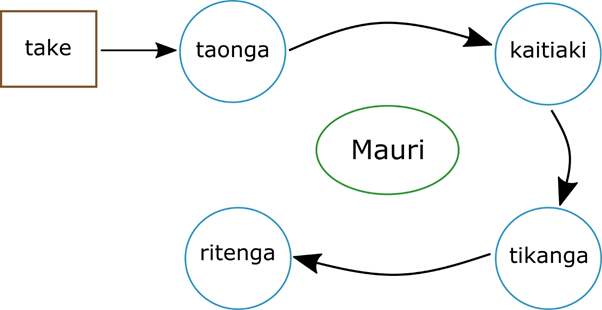Mauriora Systems Framework: A guide and process for decision-making
In this section
-
Reducing nitrogen losses from farms
- Measuring and modelling paddock water inputs and losses on stony soils
- Annual net inputs and losses of carbon and nitrogen for irrigated and non-irrigated lucerne
- Carbon inputs to reduce nitrogen losses
- Sward species and cattle diet effects on nitrogen losses
- Contrasting microbial activities in topsoil and subsoil
- Identifying soils with low nitrogen losses
- Mauriora Systems Framework: A guide and process for decision-making
- Recommendations for farmers
Key findings
- The Mauriora Systems Framework is a decision-making guide and tool grounded in Te Ao Māori (the Māori world). Here we apply this framework to a production context
- The Mauriora Systems Framework is based on the interaction between four key concepts: taonga, kaitiaki, tikanga, and ritenga
- We aim to use the Mauriora Systems Framework to build a collaborative knowledge approach that acknowledges the benefits of utilising Mātauranga Māori, western science, and other knowledge systems (e.g., community knowledge) to various problems in the farming sector
The Mauriora Systems Framework (Matunga, 1993) is a decision-making framework grounded in Te Ao Māori (the Māori world). With a focus on protecting, maintaining and enhancing the mauri, life essence and regenerative capacity of taonga (valued resources) the framework can be applied to take (i.e. development propositions and proposals) in resource governance, management, policy, and planning. The Mauriora Systems Framework has an emphasis on the interconnection between taonga as demonstrated by the philosophy of Ki Uta Ki Tai, (from the mountains to the sea) and potential flow-on effects of our actions on the natural environment. Applying this philosophy, we recognise that these actions affect the mauri of the land, water, and soil well beyond our immediate farm boundaries.
The Mauriora Systems Framework is based on the interaction between four key concepts: taonga, kaitiaki, tikanga, and ritenga as demonstrated below.

Diagram from Matunga (1993) illustrating the application of the Mauriora Systems Framework to assist decision-making grounded in Te Ao Māori with a focus on protecting, maintaining and enhancing the mauri and regenerative capacity of taonga
To apply the Mauriora Systems Framework, we must first identify what taonga might be affected by the take or proposition. From this we can then identify the tangata whenua who have mana (authority) as iwi, hapu, whanau and responsibilities as kaitiaki (custodians) for the taonga. Identifying the tangata whenua/kaitiaki also helps determine the critical Māori community/ies of interest that must be involved in any decision-making process. The first two concepts, taonga and kaitiaki, help spatialise the framework within the broader context of the landscape, ecosystem, catchment, and even region. Kaitiaki can then process the proposition according to their tikanga (i.e., kaitiakitanga, manaakitanga etc.). Their tikanga (i.e., values and ethics) must be applied to and underpin any decision-making about the take or proposition. Working through this process helps determine a response to the proposition or issue initially proposed at the beginning of the framework. Finally, we end with ritenga, (i.e., implication) of applying nga tikanga to the take. The process is iterative eventually leading to a decision, to the satisfaction of the kaitiaki - hopefully.
In our research, we are applying the Mauriora Systems Framework to a land-based production context to better understand the impacts of different modes, types and intensities of production on the mauri (collectively and individually) of various taonga including one (soil), hau (air), whenua (land), and wai (water). Recent years have seen increased nutrient levels and runoff to waterways which flow into one of Ngāi Tahu’s most important mahinga kai (food gathering areas), Te Kete Ika a Rakaihautu (the fish/food basket of Rakaihautu), also known as Te Waihora or Lake Ellesmere. This has significant effects on the ability of tangata whenua to protect and enhance their mahinga kai. To better understand the effects of farming activity on the environmental and cultural fabric of our landscape, we need to extend the context of nitrogen loss well beyond the farm gate to broader ecosystem, catchment, and regional scales.
The Ashley Dene Research & Development Station is located in the catchment that drains into Te Waihora so the research in this programme is very relevant for informing and progressing the development of the Framework. We aim to use the Mauriora Systems Framework to build a collaborative knowledge approach, that acknowledges the benefits of utilising Mātauranga Māori, western science, and other knowledge systems (e.g., community knowledge) to various problems in the farming sector. We are seeking to apply a multiple knowledge approach through collaboration. Initial discussions have been held with various science themes in the programme to progress knowledge sharing and exchange in order to apply the framework. There are multiple ways of viewing the problem of nitrogen losses from farms. By applying the Mauriora Systems approach to this issue we will be able to better understand the true effects of this problem beyond the farm gate and farm boundary.
For more details go to:
Matunga, H (1993) pp12-20 in Blackford, C and Matunga, H. Social, Cultural and Spiritual Effects of Hazardous Substances and New Organisms. Unpublished Report for the Ministry for the Environment. Centre for Resource Management, Lincoln University.
